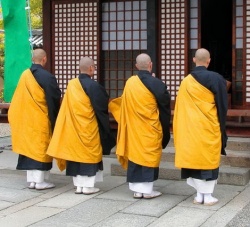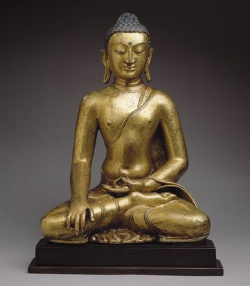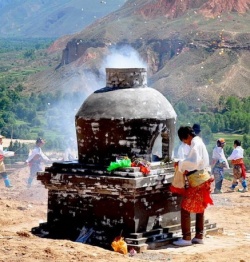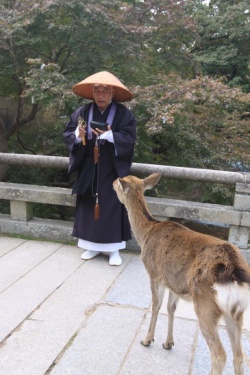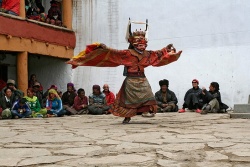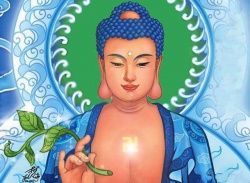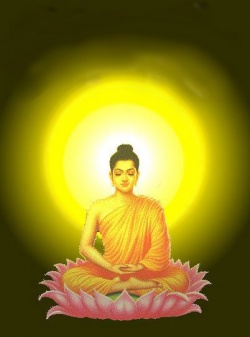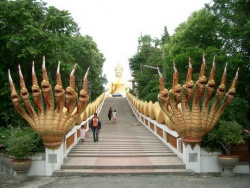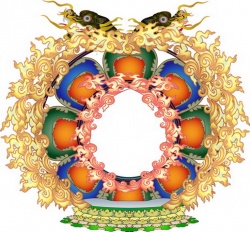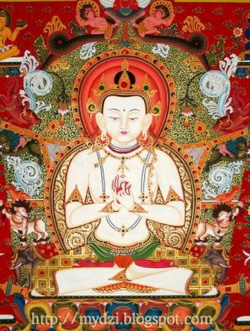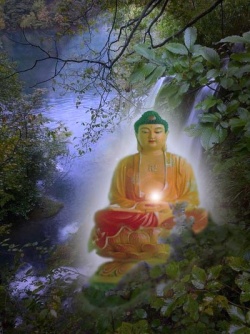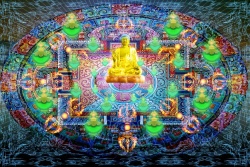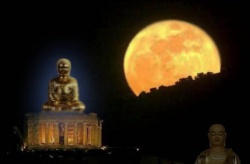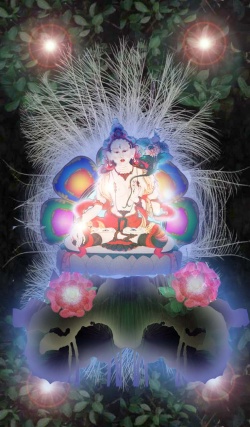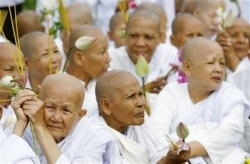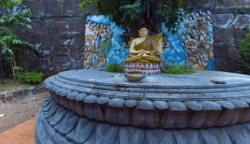Lakshmi
Lakshmi (Sanskrit: :wikt:लक्ष्मी lakṣmī, is the Hindu Goddess of wealth, prosperity (both material and spiritual), fortune, and the embodiment of beauty.
She is wife of Vishnu.
Also known as Mahalakshmi, she is said to bring good luck and is believed to protect her devotees from all kinds of misery and money-related sorrows.
[1] Representations of Lakshmi are also found in Jain monuments.
Lakshmi is called Shree or Thirumagal because she is endowed with six auspicious and divine qualities, or Gunas, and also because she is the source of strength even to Vishnu.
When Vishnu incarnated on the Earth as the avatars Rama and Krishna, Lakshmi took incarnation as his consort. Sita (Rama's wife), Radha (Krishna's lover),[2][3][4] Rukmini and Satyabama are considered forms of Lakshmi.[5]
Lakshmi is worshipped daily in Hindu homes and commercial establishments as the goddess of wealth. She is also worshipped as the consort of Vishnu in many temples. The festivals of Diwali and Kojagiri Purnima are celebrated in her honour.
Explanation of Goddess lakshmi
As per Devi, the Supreme power, is called Durga or Shakti.
The abstract power has been imagined by the Hindus as Durga Shakti.
Both Lakshmi and Saraswati are forms of Durga or Shakti or Tridevi the eternal consort power of Parabrahman the Trimurti.
By the help of the Supreme soul (Adi Purusha) to create the Supreme Power (Adi-shakti), three other shapes have been created from the Supreme Power.
She is seen in two forms, Bhudevi and Sridevi, both either side of Sri Venkateshwara or Vishnu.
Bhudevi is the representation and totality of the material world or energy, called the aparam Prakriti, in which she is called Mother Earth. Sridevi is the spiritual world or energy, called the Prakriti.
Most people are mistaken that they are separate beings although they are one, that is, Lakshmi.
Lakshmi is the power of Vishnu. Template:Citation needed
Mahalakshmi's presence is also found on Sri Venkateswara (at Tirumala) or Vishnu's chest, at the heart. Lakshmi is the embodiment of love, from which devotion to God or Bhakti flows.
It is through Love/Bhakti or Lakshmi that the atma or soul is able to reach God or Vishnu.
Lakshmi plays a special role as the mediator between her husband Vishnu and his worldly devotees.
Lakshmi represents a more soothing, kind, warm and approachable mother figure who willingly intervenes in the lives of devotees.
When asking Vishnu for grace or the forgiveness, the devotees often approach Him through the intermediary presence of Lakshmi.[6]
She is also the personification of the spiritual Fulfillment.[7] Also, she embodies the spiritual world, also known as Vaikunta, the abode of Lakshmi-Narayana or Vishnu, or what would be considered Heaven in Vaishnavism.
She is also the divine qualities of God and the soul. Lakshmi is the embodiment of God's superior spiritual feminine energy, Param Prakriti, which purifies, empowers and uplifts the individual.
, she is called the Goddess of Fortune. She is believed to be the mother of the universe.
Creation and legends
Devas (gods) and asuras (demons) were both mortal at one time, in Hinduism.
Amrit, the divine nectar that grants immortality, could only be obtained by churning the Kshirsagar (Ocean of Milk). The devas and asuras both sought immortality and decided to churn the Kshirsagar.
The samudra manthan commenced with the devas on one side and the asuras on the other. Vishnu incarnated as Kurma, the tortoise,
and a mountain was placed on the tortoise as a churning pole. Vasuki, the great venom-spewing serpent, was wrapped around the mountain and used to churn the ocean.
A host of divine celestial objects came up during the churning.
Along with them emerged the goddess Lakshmi. In some versions she is said to be the daughter of Varuna, the sea god since she emerged from the sea.
According to Vishnu Purana she is said to be the daughter of Bhrigu and Khyaati and resided in Swarga, but left Swarga and made Ksheersagara her home due to the curse of Durvasa and later emerged again after the churning of the ocean.
In some versions, after her emergence from the sea, she accepted Vishnu as her consort while in some she was already Vishnu's consort.
The moon (chandra) also appeared from the ocean during the churning, making it her brother.
Etymology
The etymology and meanings of the word lakshmi is given in Monier Williams' Sanskrit–English Dictionary compiled in the 19th century in British India.
- laksmIka meaning a mark, sign, or token is in Rik Veda x, 71, 2 and Nirukta iv, 10.
- laksmi ( with or without pAp'I ) is a bad sign or an impending misfortune referred to Atharva Veda and [Apasthambha Shrauta Sutra)].
- In older Sanskrit, it is usually used with "p'uNyA" meaning a good sign, good fortune, prosperity, success, or happiness in Atharva Veda.
- Laksmi personifies wealth, riches, beauty,happiness, loveliness, grace, charm and splendour in Mahabharata.
- Laksmi as a noun is a goddess of fortune and beauty (frequently in the later mythology identified with Śrī and regarded as the wife of Viṣṇu or Nārāyaṇa).
- According to Sir Monier Williams, "Religious thought and life in India", 45, 40-43 she sprang with other precious things from the foam of the ocean when churned by the gods and demons for the recovery of the Amṛta. She appeared with a lotus in her hand, whence she is also called Padmā.
- According to another legend, she appeared at the creation floating over the water on the expanded petals of a lotus flower; she is also variously regarded as wife of Sūrya, as wife of -pati, as wife of Dharma and mother of Kāma, as sister or mother of Dhātṛ and Vidhātṛ, as wife of Datt^atreya, as one of the nine Śaktis of Viṣṇu, as a manifestation of Prakṛti, as identified with Dākshāyaṇī in Bharat^aśrama, and with Sītā, wife of Rāma, and with other women.
Names
Lakshmi in Sanskrit is derived from its elemental form lakS, meaning "to perceive or observe".[8] This is synonymous with lakṣya, meaning "aim" or "objective". Lakshmi has many names. She is known to be very closely associated with the lotus, and her many epithets are connected to the flower, such as:
- Padma: lotus dweller
- Kamala: lotus dweller
- Padmapriya: One who likes lotuses
- Padmamaladhara devi: One who wears a garland of lotuses
- Padmamukhi: One whose face is as beautiful as a lotus
- Padmakshi: One whose eyes are as beautiful as a lotus
- Padmahasta: One who holds a lotus
- Padmasundari: One who is as beautiful as a lotus
Her other names include:
- Vishnupriya: One who is the beloved of Vishnu
- Ulkavahini: One who rides an owl
Her other names include:
Manushri,
Chakrika,
Kamalika,
Aishwarya,
Lalima,
Kalyani,
Nandika,
Rujula,
Vaishnavi,
Samruddhi,
Narayani,
Bhargavi,
Sridevi,
Chanchala,
Jalaja,
Madhavi,
Sujata,
Shreya.
She is also referred to as Jaganmaatha ("Mother of the Universe") in Shri Mahalakshmi Ashtakam. Rama and Indira are popular.
Iconography
Lakshmi is described as bestowing coins of prosperity and flanked by elephants signifying her royal power.
However, in some texts, she has an owl as her vahana. Her expression is always calm and loving. The lotus also symbolizes the fertile growth of organic life, as the world is continually reborn on a lotus growing out of Vishnu's navel.
Lakshmi is worshipped daily, but special focus is given in the month of October. Her worship ceremonies include people offering food and sweets, chanting her 108 names, prayers being repeated, and devotional songs being sung.
A 1400-year-old rare granite sculpture of Lakshmi has been recovered at the Waghama village along the Jehlum in Anantnag district of Jammu and Kashmir.[9]
Secondary manifestations
Ashta Lakshmi (Sanskrit: अष्टलक्ष्मी,Aṣṭalakṣmī, lit. "eight Lakshmis") are a group of eight secondary manifestations of Lakshmi, who preside over eight sources of wealth and thus represent the powers of Shri-Lakshmi.
Actually, Mahalakshmi presides over eighteen forms of wealth, ten of which are the eight great siddhis called Ashta Siddhis, the spiritual knowledge or Gnana, and teaching or imparting the spiritual knowledge to the entire world without any class difference.
Mahalakshmi is also known to preside over 16 forms of worldly wealth excluding Ashta siddhis, gnana and imparting gnana. They are as follows:
Fame;
Knowledge;
Courage and
Strength;
Victory;
Good Children;
Valor; Gold,
Gems and
Other Valuables;
Grains in abundance;
Happiness; Bliss;
Intelligence;
Beauty;
Higher Aim,
High Thinking and
Higher Meditation;
Morality and
Ethics;
Good Health;
Long Life.
| आदि लक्ष्मी (ఆదిలక్ష్మి; ಆದಿಲಕ್ಷ್ಮಿ) | Ādi Lakṣmī | The First manifestation of Lakshmi |
| धान्य लक्ष्मी (ధాన్యలక్ష్మి; ಧಾನ್ಯಲಕ್ಷ್ಮಿ) | Dhānya Lakṣmī | Granary wealth |
| धैर्य लक्ष्मी (ధైర్యలక్ష్మి; ಧೈರ್ಯಲಕ್ಷ್ಮಿ) | Dhairya Lakṣmī | Wealth of courage |
| गज लक्ष्मी (గజలక్ష్మి; ಗಜಲಕ್ಷ್ಮಿ) | Gaja Lakṣmī | Elephants, symbols of wealth |
| सन्तान लक्ष्मी (సంతానలక్ష్మి; ಸಂತಾನಲಕ್ಷ್ಮಿ) | Santāna Lakṣmī | Wealth of continuity, progeny |
| विजय लक्ष्मी (విజయలక్ష్మి; ವಿಜಯಲಕ್ಷ್ಮಿ) | Vijaya Lakṣmī | Wealth of victory |
| विद्या लक्ष्मी (విద్యాలక్ష్మి; ವಿದ್ಯಾಲಕ್ಷ್ಮಿ) | Vidyā Lakṣmī | Wealth of knowledge and education |
| धन लक्ष्मी (ధనలక్ష్మి; ಧನಲಕ್ಷ್ಮಿ) | Dhana Lakṣmī | Monetary wealth |
The type of Ashta Lakshmis differ with every yuga and thus one would not find uniformity in the names of Ashta lakshmis in Hindu sacred texts.
There are more than a crore manifestations of Mahalakshmi; without her nothing in this world would survive as she forms the basis of the entire gamut of creation. Without her grace, there will be nothing to eat, no air to breathe, no progeny in continuation etc. At a minor level, one cannot survive without monetary wealth in this wide world, if one has not developed spiritualism.
Even if one were to beg, one would not get even a dime without the grace of Mahalakshmi. It is only through the grace of Mahalakshmi that even the King of Gods, Devendra, gained wealth, when He was cursed by the famous sage Dhurvasa for disrespecting the garland offered to Him.
Mahalakshmi is said to exist in several other forms. The most famous amongst them are Sridevi, Bhoodevi, and Neeladevi.
The famous Vaishnavite saint Aandaal, who was born in Srivilliputhur in Tamil Nadu, about 5050 years ago, is an incarnation of Mahalakshmi herself. Sridevi represents moveable assets, called Chanchala in Sanskrit. Bhoodevi represents immoveable assets (Achanchala).
It is because of this that mountains in India are prefixed with Achanachala, for example, Arunachala, Himachala etc. The term chanchala also denotes fickleness, which is why people are not always wealthy.
Everything in this world operates only with the grace of Mahalakshmi.
In addition, according to the Kalki Purana, when Vishnu incarnates as Kalki, she will appear as his wife in the form of Padma and give birth to two sons.[10] Template:Wide image
Celebration in Hindu society
Hindus worship Lakshmi the most on Diwali, the festival of lights. According to tradition, people would put small oil lamps outside their homes on Diwali in hopes Lakshmi will come to bless them.
The prefix Sri (also spelled Shri, pronounced as shree) translates as "one who takes delight in". Therefore, Sri Lakshmi, means wealth of any kind.
Any thing that need be affluent gets the auspicious prefix or suffix Lakshmi, or Sri, such as Rajya Lakshmi (Wealth of Empire), Shanti Sri (Wealth of Peace), etc.
In modern India, common titles standing in for the English Mr. and Mrs. are Shri (also Sri or Shree) and Shrimati (also Srimati or Shreemati), as in Sri desai or Srimati shanti.
In Uttarakhand, after the worship of the goddess on Diwali night, the shankha, or conch, is not blown.
This is because the shankha is also from the ocean like the goddess herself, so it is given a day of rest.
Karaveera Nivasini Mahalakshmi, also known as Ambabai, is the patron goddess of Kolhapur city, Maharashtra.
Bengal
Concept
In Bengal, Lakshmi is worshiped in autumn when the moon is full, the brightest night of the year. It is believed that she showers wealth on this night.
She, along with her mount, the great white owl, come into contact with our worlds and takes away the darkness of poverty, stagnation, anger, and laziness from our lives.
Her vahana owl represents royalties, penetrating sight and intelligence.
It serves as her mount over which she has full control. Lakshmi is also referred to as pranadayini("giver of vital life-sustaining energy") who can turn a dull thing full of life.
In the Sri Vaishnava philosophy, Sri (Lakshmi) is honored as the Iswarigm sarva bhootanam, i.e., the supreme goddess and not just the goddess of wealth.
Lakshmi is depicted in a red costume, which represents continuous activity, or in a golden costume, representing fulfillment. She wears ornaments full of gold and a golden ruby-studded crown.
Her hair is long, dark and wavy.
Her complexion is golden, representing a boon-giver. She shows the abhaya mudra or the gyan mudra with her right hand and holds a potful of gold in her left arm and paddy sheaf in her left hand.
Worship
Lotus flowers, sandalwood, vermilion, betel leaves & nuts, fruits and various sweet preparations made from jaggery, rice and coconuts are used for her ritual worship.
Apart from the autumnal celebration, Lakshmi, along with Alakshmi (her shadow energy), is also worshipped during Diwali night in some Bengali communities.
Goddess Kali of Kalighat in Kolkata is worshipped in Mahalakshmi form during Diwali.
Observing a Lakshmi Brata/Puja on Thursdays or during full moon days is quite popular. A string of poems called 'Panchali', narrating the glories of the Goddess, is sung by women.
Odisha
Manabasa Gurubara
With the harvest brought home, the farmers feel greatly satisfied with the yield.
After six months of toil in the field, they fill the granaries with the blessings of Lakshmi.
So, the whole month of Mrigashīrsha (December–January) is spent in worshiping the goddess.
All the rituals connected with the festival Manabasa Gurubara or Lakshmi Puja are done by housewives.
On each Thursday of the month, the houses are plastered with cow dung, and the floors are decorated with beautiful floral designs drawn with rice powder mixed with water, called jhoti.
Footprints are painted from the doorstep to the place of worship, as if Lakshmi has entered the house. The roofs are decorated with flower garlands and festoons woven out of paddy stalks.
Main ritual
After a purification bath in the morning, the homemakers worship the goddess, not through an image, but significantly through paddy measures. Different rice cakes and Khiri (rice soup prepared with milk and sugar) are prepared in every household and are offered to the deity and then eaten by all.
Legend
In the evening, the Laxmi Puran, in which an interesting story is told, is read or recited. Once Shreeya, worshiped Lakshmi by observing this festival.
Moved by her devotion, Lakshmi left her permanent abode, the temple that is inside the campus of the temple of Jagannatha, and visited Shreeya's house.
When Balabhadra, the elder brother of Jagannatha, came to know about this, she was declared defiled and was not allowed to come back into the temple. Lakshmi was deeply hurt and went to her father, Sagara.
When Lakshmi went out of the temple, all wealth in the temple started vanishing. Later, Balabhadra and Jagannatha could not find food to sustain themselves.
They came out of the temple in the attire of Brahmin beggars in search of food.
Ultimately,
They landed at the door of Lakshmi. Balabhadra apologised for the mistake, and all of them returned to the temple.
Gaja
Gaja Lakshmi Puja is celebrated in the Sharad Purnima, the full-moon day in the Oriya month of Aswina(September–October). This autumn festival is one of the most popular and important festivals of Odisha.
The goddess of wealth is worshiped for one day and, in some places, it is celebrated for seven to ten days. The festival is religiously celebrated by the business community in Odisha.
All over Odisha, richly decorated and beautifully made images of Gaja Lakshmi are installed.
The festival instills a spirit of holiness and sanctity into the whole community, so much so that people of other faiths participate in it with abundant warmth and sincerity.
In Odisha, this festival, also known as Kumar Purnima, falls on the full moon - Purnima. Girls and boys wear new clothes and generally have a good time with family and friends.
In the early morning, the girls, after their purification baths, wear new garments and make food offerings to the sun. They observe fasting for the day.
In the evening, when the moon rises, they again make food offerings of a special variety and eat it after the rituals are over.
It is a festival of rejoicing for the girls; all of them sing and dance. The songs are of a special nature. They play a kind of game known as puchi and other country games.
Worship
There are innumerable slokas in praise of Mahalakshmi.
Some of the most famous prayers for worshipping her are "Sri Mahalakshmi Ashtakam", "Sri Lakshmi Sahasaranama Sthothra" by Sanathkumara, "Sri Stuti" by Sri Vedantha Desikar,
Sri Lakshmi Stuti By Indra)], "Sri Kanakadhara Sthothra" by Aadhi Shankaracharya, "Sri Chatussloki" by Sri Yamunacharya,
"Sri Lakshmi Sloka" by Bhagavan Sri Hari Swamiji and Sri Sukta which is contained in the Vedas.
The famous Lakshmi Gayathri Sloka, "Om Mahalakshmichae Vidmahe sri Vishnupathinichae Dhi-Mahi Thanno Lakshmi Prachodayat" is a prayer to Lakshmi contained in the Sri Sukta.
There is another famous prayer pronounced by the great sage Agastya:
"Agastya Lakshmi Stotra". Although Mother Lakshmi is worshiped as the goddess of fortune, when she is worshiped with Narayana, the worshiper is blessed with not only wealth but also peace and prosperity.
They can be worshiped in forms, such as Lakshmi Narayana, Lakshmi Narasimha, Sita Rama, Radha Krishna, or Vithal Rukmini.
Mantra
- Sanskrit:[11] ॐ श्रीं ह्रीं क्लीं त्रिभुवन महालक्ष्म्यै अस्माकम् दारिद्र्य नाशय प्रचुर धन देहि देहि क्लीं ह्रीं श्रीं ॐ
- English transliteration: oṃ śrīṃ hrīṃ klīṃ tribhuvana mahālakṣmyai asmākam dāridrya nāśaya pracura dhana dehi dehi klīṃ hrīṃ śrīṃ oṃ
Respect for money
In many areas of India it is customary that, out of respect, when a person's foot accidentally touches money (which is considered as a manifestation of Lakshmi) or another person's leg, it will be followed by an apology in the form of a single hand gesture (Pranāma) with the right hand, where the offending person first touches the object with the finger tips and then the forehead and/or chest. This also counts for books and any written material, which are considered as a manifestation of the goddess of knowledge Saraswati.[12]
Temples
- Maruthathoor Sree Mahalakshmi Temple( Thiruvananthapuram,Neyyattinkara)
- Mahalakshmi Temple (Dahanu)
- Mohiniraj Laxmi Temple Newasa Dist Ahmednagar Maharastra
- Mahalaxmi Temple (Hedavde)
- Ashtalakshmi Kovil, Chennai
- Ashtalakshmi Temple, Hyderabad
- Mahalakshmi Temple, Kolhapur
- Mahalakshmi Temple, Mumbai
- Sri Mahalakshmi Temple, Goravanahalli near Bangalore
- Mahalakshmi Temple, BrazilTemplate:Citation needed
- Sri Mahalakshmi Temple, Eachanari, Coimbatore
- Mahalakshmi Temple, Jhansi
- Vaishno Devi, katra
See also
References
Footnotes
- ↑ Das, Subhamoy. "Lakshmi: Goddess of Wealth & Beauty!". Hinduism.about.com. http://hinduism.about.com/od/hindugoddesses/p/lakshmi.htm. Retrieved 2012-11-09.
- ↑ Encyclopaedia of Hindu Gods and Goddesses; by Suresh Chandra
- ↑ "Radha - Goddess Radha, Sri Radharani, Radha-Krishna, Radhika". Festivalsinindia.net. http://www.festivalsinindia.net/goddesses/radha.html. Retrieved 2012-11-09.
- ↑ Radha in Hinduism, the favourite mistress of the god Krishna, and an incarnation of Lakshmi. In devotional religion she represents the longing of the human soul for God: The Oxford Dictionary of Phrase and Fable (2006); Elizabeth Knowles |
- ↑ Essential Hinduism; by Steven Rosen (2006); p. 136
- ↑ Pages 31 and 32 in Kinsley, David. Hindu Goddesses: Vision of the Divine Feminine in the Hindu Religious Traditions. Berkeley: University of California Press, 1988. ISBN 978-0-520-06339-6
- ↑ Srimad Devi Bhagwata Purana
- ↑ Monier-Williams Sanskrit-English Dictionary.
- ↑ "The Tribune, Chandigarh, India - Jammu & Kashmir". Tribuneindia.com. http://www.tribuneindia.com/2009/20090413/j&k.htm#20. Retrieved 2012-11-09.
- ↑ Template:Cite book
- ↑ "Lakshmi(Laxmi) Mantra and Stotra | Astrology-Vastu-Mantra | VEDIC RISHI". Vedicrishi.in. http://www.vedicrishi.in/mantra/index/act/lakshmi-mantra. Retrieved 2012-11-09.
- ↑ DeBruyn, Pippa; Bain, Keith; Venkatraman, Niloufer (2010). Frommer's India. pp. 76.
Further reading
- Template:Cite book
- Hindu Goddesses: Vision of the Divine Feminine in the Hindu Religious Traditions (ISBN 81-208-0379-5) by David Kinsley
- Lakshmi Puja and Thousand Names (ISBN 1-887472-84-3) by Swami Satyananda Saraswati
